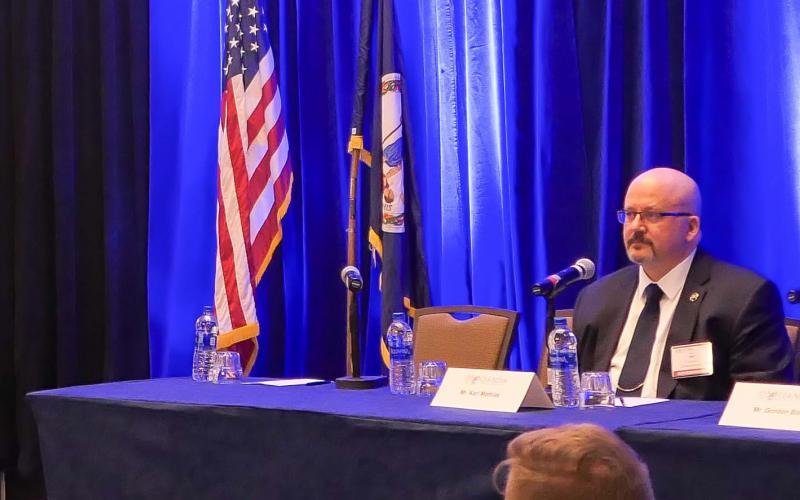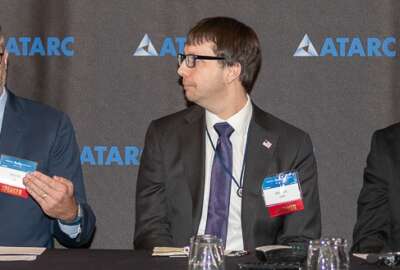Broken processes spurred the Marshals Service’s IT modernization effort
Karl Mathias, the chief information officer of the U.S. Marshals Service, said he hired a new chief technology officer to help develop a 5-to-10 year technology...
Best listening experience is on Chrome, Firefox or Safari. Subscribe to Federal Drive’s daily audio interviews on Apple Podcasts or PodcastOne.
The U.S. Marshals Service’s technology modernization effort has little to do with the actual technology. The Justice Department bureau is upgrading its processes that will lead to successful IT implementations.
Karl Mathias, the chief information officer of the U.S. Marshals Service, said the agency is adopting a risk-based and agile approach to system updates.
“Agile is a methodology for developing applications and we use it for everything from change management to our infrastructure,” Mathias said on Ask the CIO. “You have the product owner in there with you and you are incrementally rolling pieces out, showing them as you go out and having that product owner in there in these sprints which can be two-to-four weeks so they are seeing it as it goes out.”
He said agile is a major step toward dev/ops but the two concepts are not synonyms.

“When we go over to dev/ops, I think of it as additive. I think agile helps you as you go to dev/ops because you basically have your developers in there creating code or enhancing an existing application. But when they commit the code, there is an automatic set of trusted processes that take you from the developer committing code to production,” Mathias said. “It’s more about getting your operations and developers synced up versus agile is more about the development itself.”
The Marshals Service is moving toward agile and eventually dev/ops, but there still are some legacy systems where the waterfall approach remains in place.
“The dev/ops side is a whole different animal for us than waterfall because the operations side who were used to throwing up a castle wall around their systems now have to open the walls to the developers and that’s a bit of a nerve-racking experience,” Mathias said. “We are taking slow steps on that and we are still working out the exact way we want to do it. We actually will be looking for vendor help along the way. We want to let them tell us what is the best way to approach this.”
Backlog of application development priorities
The focus on process improvements first and technology second is an outgrowth of two findings. First, the Marshals Service was spending about 80% of its IT budget on legacy systems. Second, the service had a backlog of application development and fielding.
“The cybersecurity folks wanted to treat everything as if it was a brand new $100 million project so you were having things hung up. That was a process problem and it was chewing up manpower,” Mathias said. “What we did was we said we will adopt a risk-based approach. We will not run everything through every board you can. We will say here is the criteria for something that is relatively minor like changing the color on the screen or changing the label on a field, to making minor modifications on data, which then must bring in a lower-level of review, to finally this is a brand new large project and it has to go through the whole authority to operate process (ATO).”
Mathias said by changing these processes, the service reduced the employee resources it took to field new applications.
As the Marshals adopts dev/ops, it will use automated tools to remove human interaction with the process at the appropriate steps to ensure applications get to the end user more quickly.
By removing the human in the loop for every box that needs to be checked, Mathias said employees will be freed up to work on more valuable, more capability-driven projects.
Suffice it to say, the Marshals still will be looking for and implementing plenty of new software and cloud services in the coming years.
Technology roadmap under development
Mathias said he brought in a new chief technology officer, Christine Finnelle, to help determine the service’s IT path over the next five years.
“It’s easy to get caught into the trap of just looking one year ahead. I will thank the Department of Defense for training me to look five years ahead. That’s my goal for us to look five years ahead at a minimum to say where do I want to be in 5 or 10 years?” he said. “Where do we want to be in five years? I told my staff we’ve made our last major hardware purchase for data centers. We are in two FBI data centers. We don’t own our own data centers. I have hardware in there and it has three or four years of life left in it. At the end that, I intend to be in the cloud to the maximum extent I can.”
To get there, Mathias said he needs a technology and process roadmap, which goes back to the need to improve their processes both in the IT organization and in the business areas.
“What we’ve done over the last few months is develop a process for agency planning for IT that is far more formal. We have that approved through leadership now. Instead of just Karl Mathias, we will do what we are supposed to do. We will have the CFO in there, we will have my boss, the associate director for administration, the associate director of operations, a marshal and two chief deputy U.S. Marshals. These will be senior people who will prioritize the projects and they will be scored through assessments.”
He added the new investment review board will help make sure the entire agency knows its IT priorities.
Among those shorter term priorities are the continued modernization of the Marshals’ Capture system, which integrates operational business and mission capabilities, consolidates operational data and improves operational business processes. The Marshals are in year two of a three year project that includes six release updates to move these capabilities, including an incident alerting system, to the cloud.
The other major modernization programs are the Marshals’ warrant and prisoner tracking systems.
“The first initial capability of the prisoner tracking system will be coming out as a pilot with a couple of districts. Then later in the fall as we iron the kinks out with those two districts, it will be a large roll out to the rest of the agency,” Mathias said. “We want to make sure there is a mobile capability as part of this. It would be easy to get it out to your iPhone or Android device, but it has to be secure. That’s where it gets tricky. We are constantly running into challenges because developers want to put things out quick and easy and my cyber folks are saying, ‘timeout.’ Then you go back and have that discussion. We are working through it and it’s very exciting.”
Copyright © 2025 Federal News Network. All rights reserved. This website is not intended for users located within the European Economic Area.
Jason Miller is executive editor of Federal News Network and directs news coverage on the people, policy and programs of the federal government.
Follow @jmillerWFED







